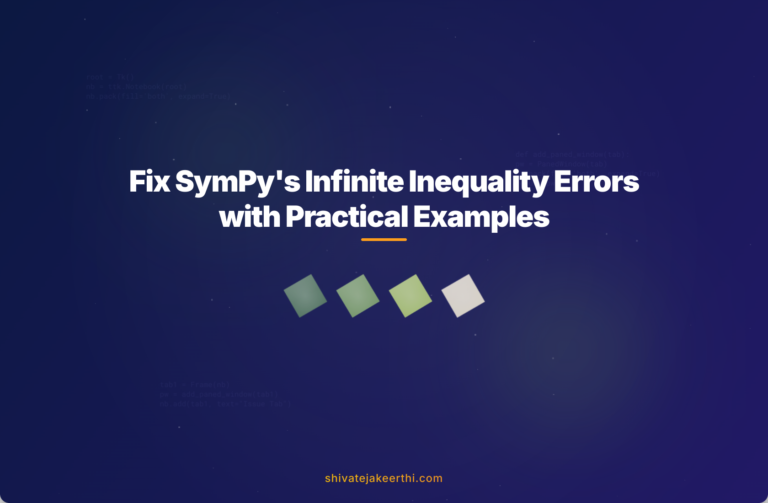When you’re working on symbolic mathematics problems in Python, SymPy often becomes your go-to tool. SymPy is powerful because it lets you do algebra, calculus, and even handle equations symbolically.
But if you’ve encountered inequalities involving infinite symbols like oo (infinity) in SymPy, you might have noticed incorrect evaluations or unexpected results. Maybe you’ve found SymPy stating something absurd, like infinity being equal or comparable incorrectly.
This issue might lead to major confusion and errors if not addressed promptly. In this article, we’ll unpack why SymPy struggles with inequalities involving infinite symbols, review examples of incorrect evaluations, and most importantly, show you exactly how to fix these problems effectively.
How Does SymPy Handle Infinite Symbols in Inequalities?
Understanding how SymPy processes inequalities involving infinity will help identify why it sometimes produces odd evaluations.
SymPy represents positive infinity as oo and negative infinity as -oo. When you define inequalities involving these symbols, you might expect straightforward results. For example, logically we know that any positive real number is always less than infinity. Let’s look at a simple snippet:
from sympy import symbols, oo
x = symbols('x', real=True)
inequality = (x < oo)
print(inequality)
Intuitively, you'd expect this inequality to consistently hold true for real values of x, right? But SymPy sometimes incorrectly stores or evaluates these inequalities—especially during more complex symbolic operations.
The confusion usually stems from users making small but impactful mistakes when defining symbols or conditions involving infinity. Common mistakes include:
- Not clearly declaring the domain of symbols.
- Not applying correct symbolic assumptions explicitly.
- Expecting automatic evaluations without explicit conditions.
These small slip-ups can inadvertently cause misinterpretations in evaluations down the line, causing computational confusion.
Why Does SymPy Incorrectly Evaluate Inequalities with Infinity?
At the core, SymPy's inaccurate handling of inequalities involving infinity stems from handling "extended nonnegative values". It's due to a combination of how symbolic assumptions and internal representations work, and more importantly, when infinite bounds aren't explicitly set via assumptions.
SymPy treats infinity (∞) as an extended value rather than a regular numeric boundary. The library sometimes lacks explicit checks or assumptions for comparisons involving infinite operands. Let's illustrate with a common problematic example:
from sympy import oo
print(oo > oo) # You might expect False
print(oo >= oo) # You might assume True
Surprisingly, the above calls don't return simple True or False evaluations clearly, leading to uncertainty and potential wrong outcomes during symbolic computations such as integration, optimization, or constraint checking.
Without explicit handling, SymPy remains uncertain due to the ambiguous evaluation of infinite comparisons. This "uncertainty" factor is crucial to understanding why SymPy can misbehave with infinite symbols in inequalities.
How Can We Fix Incorrect Infinity Evaluations in SymPy?
Now, let's move to the exact solutions and methods for handling infinite symbols correctly—helping your inequalities evaluate reliably.
First and foremost, always explicitly specify symbolic assumptions clearly. For instance, if you have a variable potentially going to infinity, set its domain properly:
from sympy import symbols, oo, ask, Q
x = symbols('x', real=True)
print(ask(Q.real(x) & Q.finite(x)))
print(x < oo) # Evaluates correctly with explicit finite assumption
Here, explicitly setting assumptions and conditions clears up ambiguities in evaluations, leading SymPy to reliable conclusions.
Also, use explicit boundary checks. For infinite symbols, SymPy comparisons require careful explicit handling. To guarantee correctness, consider comparing numerical substitution explicitly at critical points whenever symbolic uncertainties occur.
Quick Tips to Avoid Incorrect Infinity Evaluations:
- Always declare variables' domains explicitly (e.g., finite, real, positive).
- Use inference aids like ask, assuming, and SymPy's Q assumptions (See their detailed usage on SymPy Documentation).
- Check expressions involving infinity numerically first, to ensure they behave as expected.
- Use SymPy's built-in methods like .is_finite, .is_extended_real to verify assumptions explicitly.
Here's an insightful Stack Overflow discussion illustrating how proper assumptions tackle such infinite evaluations: SymPy Infinite Comparison Issue tutorial.
Best Practices When Working With Infinite Symbols in SymPy
To effectively avoid incorrect evaluations in the future, it's crucial to adopt good practices consistently:
- Clearly define each symbol with explicit properties before comparisons.
- Double check problematic inequalities using alternative evaluations (numerical checks or logical assumptions).
- Always perform explicit assumption checks for infinite domains (check out other Python tips and practices).
- Implement test cases to clearly identify and confirm behavior in edge scenarios involving infinity.
Let's illustrate a best-practice example clearly:
from sympy import Symbol, oo, assuming, Q, ask
x = Symbol('x', real=True)
with assuming(Q.real(x) & Q.finite(x)):
result = ask(Q.positive(oo - x))
print(result) # Correctly returns True, confirming proper evaluation.
Real-world Examples Where Infinite Inequalities Matter
Symbolic computations involving asymptotic analysis frequently require infinity handling. Think of limit evaluation, optimization problems with infinite constraints, or integrals with infinite bounds. For instance, consider definite integral bounds where incorrect infinity handling causes wrong integral evaluation:
from sympy import integrate, oo, exp, symbols
x = symbols('x', real=True)
result = integrate(exp(-x), (x, 0, oo))
print(result) # Should return 1 correctly due to accurate infinity handling.
Clearly, accurate infinite inequality handling in SymPy ensures precision in practical applications such as theoretical physics, economics modeling, and engineering design analysis.
The Bottom Line about Infinity and SymPy Inequalities
As powerful as SymPy is, it sometimes stumbles when evaluating inequalities involving infinite values. Incorrect assumptions, ambiguous comparisons, and missing explicit evaluations cause confusion and errors. But remember—correcting this isn't difficult.
By explicitly defining your symbols, clearly setting assumptions, numerically verifying uncertain expressions, and applying SymPy's assumption modules, you'll comfortably prevent these mistakes.
Accurately handling infinite inequalities isn't just good practice; it's essential for reliable symbolic mathematics. Avoid common pitfalls, test your assumptions, and double-check results.
Want more insights into SymPy or experienced similar challenges tackling infinite-based inequalities? Feel free to share your issues or solutions in the comments below. Or explore further at the official SymPy assumptions guide to strengthen your symbolic math workflow.



0 Comments